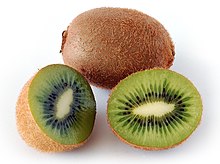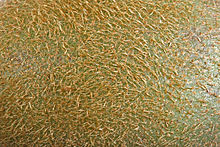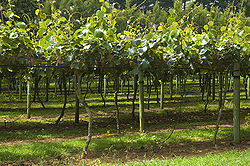This is an old revision of this page, as edited by Discospinster (talk | contribs) at 02:46, 5 November 2007 (Reverted edits by 71.202.96.86 to last version by Deor). The present address (URL) is a permanent link to this revision, which may differ significantly from the current revision.
Revision as of 02:46, 5 November 2007 by Discospinster (talk | contribs) (Reverted edits by 71.202.96.86 to last version by Deor)(diff) ← Previous revision | Latest revision (diff) | Newer revision → (diff)| Cultivar Group Kiwifruit c.v. hayward | |
|---|---|
 A whole and cut kiwifruit A whole and cut kiwifruit | |
| Species | Actinidia deliciosa |
| Cultivar group | Kiwifruit group |
| Origin | China |
| Cultivar group members | Many; see text. |
The kiwifruit is the edible fruit of a cultivar group of the woody vine Actinidia deliciosa and hybrids between this and other species in the genus Actinidia. The fruit is native to southern China.
The most common cultivars of kiwifruit are oval, about the size of a large hen's egg (5–8 cm / 2–3 in long and 4.5–5.5 cm / 1¾–2 in diameter). It has a fibrous, dull green-brown skin and bright green or golden flesh with rows of small, black, edible seeds. The texture of the fruit is soft and with a unique flavour.
In North America, South America and Europe, most people refer to the fruit simply as "kiwi", which is also the name of an indigenous New Zealand bird. Originally known as the "Chinese Gooseberry", the fruit was renamed for marketing reasons in the mid-20th century after the country's national symbol, in order to avoid a tariff on imported melons.
History
| 0.48 | |
| 0.28 | |
| 0.15 | |
| 0.08 | |
| 0.04 | |
| 0.04 | |
| 0.02 | |
| 0.02 | |
| 0.01 | |
| World Total | 1.12 |
| Source: UN Food and Agriculture Organization (FAO) | |

Actinidia deliciosa is native to southern China, where it is declared as the "National Fruit" of the People's Republic of China. Other species of Actinidia are also found in China and range east to Japan and north into southeastern Siberia. Cultivation spread from China in the early 20th century, when seeds were introduced to New Zealand by Isabel Fraser, the principal of Wanganui Girls' College, who had been visiting mission schools in China. The seeds were planted in 1906 by a Wanganui nurseryman, Alexander Allison, with the vines first fruiting in 1910.
The familiar cultivar Actinidia deliciosa 'Hayward' was developed by Hayward Wright in Avondale, New Zealand around 1924. It was initially grown in domestic gardens, but commercial planting began in the 1940s. Italy is now the leading producer of kiwifruit in the world, followed by New Zealand, Chile, France, Greece, Japan and the United States. Kiwifruit is still produced in its birthplace China, but China has never made it to the top 10 list of kiwifruit producing countries. In China, it is grown mainly in the mountainous area upstream of the Yangtze River. It is also grown in other areas of China, including Sichuan.
Names
This fruit had a long history before it was commercialised as kiwifruit and therefore had many other older names.
In Chinese:
- Macaque peach (獼猴桃 míhóu táo): the most common name
- Macaque pear (猕猴梨 míhóu lí)
- Vine pear (藤梨 téng lí)
- Sunny peach (阳桃 yáng táo)
- Wood berry (木子 mù zi)
- Unusual fruit or wonder fruit (奇異果 qíyì guǒ): the most common name in Taiwan and Hong Kong (奇異果 kay yee goh). A quasi-transliteration of "kiwifruit", literally "strange fruit".
When introduced to New Zealand by Isabel Fraser it was called yáng táo in China. People in New Zealand thought it had a gooseberry flavour and began to call it the Chinese gooseberry, although it is not related to the Grossulariaceae (gooseberry) family.
New Zealand exported the fruit to the US in the 1950s. Among the exporters was the prominent produce company Turners and Growers, who were calling the berries melonettes, because the name Chinese gooseberry had political connotations due to the Cold War. An American importer, Norman Sondag of San Francisco, complained that melonettes was as bad as Chinese gooseberry because melons and berries were both subject to high import tariffs. In June 1959, during a meeting of Turners and Growers management in Auckland, Jack Turner suggested the name kiwifruit which was adopted and later became the industry-wide name.
Most New Zealand kiwifruit is now marketed under the brand-name label Zespri which is trademarked by a marketing company domiciled in New Zealand, ZESPRI International. The branding move also served to distinguish New Zealand kiwifruit from fruit produced by other countries who could cash in on the "Kiwi" name, as it was not trademarked. From 2005, Zespri launched a new promotional campaign worldwide featuring Japanese superstar Ayumi Hamasaki as their spokeswoman.
Cultivars

Almost all kiwifruit in commerce belong to a few cultivars of Actinidia deliciosa: 'Hayward', 'Chico', and 'Saanichton 12'. The fruit of these cultivars are practically indistinguishable from each other and match the description of a standard kiwifruit given at the head of this article.

A new Cultivar Group of Actinidia chinensis known as Gold Kiwifruit or "Chinabelle", with yellow flesh and sweeter, less acidic flavour resembling a tropical fruit salad, was produced by the New Zealand Crown Research Institute, HortResearch and is being marketed worldwide in increasing volumes. Some wild vines in China have yellow fruit but are small and not commercially viable. Seeds from these plants were imported to New Zealand in 1987 and the company took 11 years to develop the new fruit through cross-pollination and grafting with green kiwi vines. Gold Kiwifruit have a smooth, bronze skin, a pointed cap at one end and distinctive golden yellow flesh with a less tart and more tropical flavour than green kiwifruit. It has a higher market price than green kiwifruit. Unlike the green cultivars, it is less hairy, so it can be eaten whole after rubbing off the thin, fluffy coat.
Food value

Kiwifruit is a rich source of vitamin C, 1.5 times the DRI scale in the US. Its potassium content by weight is slightly less than that of a banana. It also contains vitamins A and E. The skin is a good source of flavonoid antioxidants. The kiwifruit seed oil contains on average 62% alpha-linolenic acid, an omega-3 fatty acid.
Kiwifruit is often reported to have mild laxative effects, possibly because of the high level of dietary fibre.
Raw kiwifruit is also rich in the protein-dissolving enzyme actinidin, (in the same family of thiol proteases as papain), which is commercially useful as a meat tenderizer but can be an allergen for some individuals. Specifically, people allergic to latex, papayas or pineapples are likely to be allergic to kiwifruit also. Reactions include tingling and sore mouth; swelling of the lips, tongue and face; rash; vomiting and abdominal pain; and, in the most severe cases, breathing difficulties, wheezing and collapse. The most common symptoms were unpleasant itching and soreness of the mouth, with the most common severe symptom being wheezing. Severe symptoms were most likely to occur in young children.
This enzyme makes raw kiwifruit unsuitable for use in desserts containing milk or any other dairy products which are not going to be served within hours, because it soon begins to digest milk proteins. This applies to gelatin-based desserts as well, as the actinidin will dissolve the collagen proteins in gelatin very quickly, either liquifying the dessert, or preventing it from solidifying. However, the U.S. Department of Agriculture suggests that cooking the fruit for a few minutes before adding it to the gelatin will overcome this effect. Sliced kiwifruit has long been regularly used as a garnish atop whipped cream on one of New Zealand and Australia's favourite desserts, the pavlova.
Cultivation

Kiwifruit can be grown in most temperate climates with adequate summer heat. Where Actinidia deliciosa is not hardy, other species can be grown as substitutes.
Kiwifruit is commercially grown on sturdy support structures, as it can produce several tonnes per hectare, more than the rather weak vines can support. These are generally equipped with a watering system for irrigation and frost protection in the spring.
Kiwifruit vines require vigorous pruning, similar to that of grapevines. Fruit is borne on one-year-old and older canes, but production declines as each cane ages. Canes should be pruned off and replaced after their third year.
Kiwifruit plants are normally dioecious, meaning that individual plants are male or female. Only female plants bear fruit, and only when pollenized by a male plant. One male pollenizer is required for each three to eight female vines. An exception is the cultivar 'Issai', a hybrid (Actinidia arguta x rufa) from Japan, which produces perfect flowers and can self-pollinate; unfortunately it lacks vigour, is less hardy than most A. arguta forms and is not a large producer.
Kiwifruit is notoriously difficult to pollinate because the flowers are not very attractive to bees. Some producers blow collected pollen over the female flowers. But generally the most successful approach is saturation pollination, where the bee populations are made so large (by placing hives in the orchards) that bees are forced to use this flower because of intense competition for all flowers within flight distance.
Preparation and consumption


Kiwifruit can be eaten whole, like an apple (and rarely including the skin, which increases the tartness), cut in half and eaten like a passion fruit or peeled and sliced, like a pineapple. For people who prefer not to eat the skin, the fruit can be cut in half and then the flesh scooped out with a spoon. Kiwifruit is sometimes sold with a plastic tool designed for this purpose with a spoon at one end and a knife at the other. Another method is to slice the fruit into several rounds about 5 mm (¼ in) thick, possibly cutting each round into quarters, and serving it, skin-on, as a platter or with plain yogurt.
Kiwifruit can be peeled using a potato peeler, drawing up from the bottom towards the thicker, harder end where the fruit was attached to its branch. Cutting "against the grain" releases juice which lubricates the blade and a swifter, cleaner cut results.
See also
References
- http://www.zesprikiwi.com/history.htm
- http://www.123independenceday.com/china/national-symbols.html
- 李, 时珍. "本草纲目·果部". Retrieved 2007-05-07.
- Zespri site, "How Kiwifruit Got Its Name" Retrieved on July 9 2007.
- Seed Oil Fatty Acids - SOFA Database Retrieval
- Rush; et al. (2002-06). "Kiwifruit promotes laxation in the elderly". Asia Pacific Journal of Clinical Nutrition. Retrieved 2007-06-11.
{{cite web}}: Check date values in:|date=(help); Explicit use of et al. in:|author=(help) - USDA Agricultural Marketing Service (1994-01). "How To Buy Fresh Fruits" (PDF). United States Department of Agriculture . Retrieved 2006-12-02.
{{cite web}}: Check date values in:|date=(help); External link in|publisher=
External links
- Kiwis- Mahalo
- How to grow kiwi fruit vines and nutritional data
- Zespri's international website
- Purdue University NewCROP
- Kiwifruits in Australia
- NCBI's taxonomy browser
- Photos of kiwifruit and alfalfa pollination in California
- Seeka Kiwifruit Industries website

